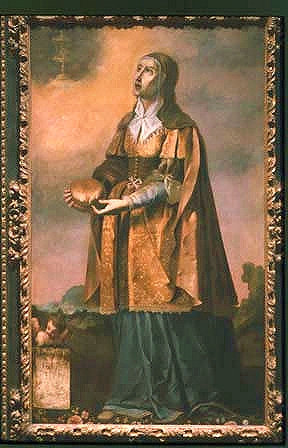 |
|
SARA
Circle of Francisco de Zubaran Spanish
1598-1664
SN 343 Oil on Canvas
by Robert Anderson
ARTIST
Francisco de Zurbaron was one of the greatest masters of the school of
Seville and is renowned for his powerful and realistic interpretation of monastic life in
17th century Spain. During the early years in Seville he was probably in contact with
other gifted painters such as Juan de Roelas, Francisco de Herrera, Diegi Velazquez and
Alonso Cano. Apart from "The Labors of Hercules" and a
large historical scene, "The Defence of Cadiz", a few portraits and some
masterly still lifes, he devoted himself almost entirely to religious works. He worked for
churches and monasteries over a wide area of Southern Spain and his paintings were also
exported to South America.
His compositionally simple and emotionally direct altarpieces,
combining austere naturalism with mystical intensity, made him an ideal
Counter-Reformation painter. His first known dated painting "Crucifixtion"
(1627) shows striking realism, brought Zurbaran immediate fame and led to numerous
commissions from other religious orders. |
The most characteristic of his works are the single figures of
monks and saints in meditation or prayer, most of which seem to have been executed in the
1630's. The figures are usually depicted against a plain background, standing out with
massive physical presence.
Towards the end of his career Zurbaran's work lost something of its power and
simplicity as he tried to come to terms with the less ascetic style of Murillo. who in the
1640's overtook him as the most popular painter in Seville. He spent his final years in
Madrid where he had gained the title of Painter to the King..
SUBJECT
This is a representation of Sara the wife of Abraham. Her story is told
in the Old Testament Book of Genesis. She was at first considered barren as she was
childless. Not unattractive, however, she was at one point abducted by a King Abimelech
because Abraham had referred to her as his sister. God then rebuked Abimelech and Sara was
returned to her Abraham.
Because she was unable to concieve Sara urged Abraham to take her
maidservant Hagar as his concubine in order to produce an heir. Late in her life Sara gave
birth to a child who was named Isaac. After the birth of Isaac, Sara convinced Abraham to
send Hagar and her son Ishmael away.
PAINTING
Sara is seen in this painting dressed in a brown coat over a dark ankle
length dress with a white neck piece. She holds a loaf of bread in her hands and looks to
the upper left of the painting at a chalice that is itself surrounded by a diffused orange
light. Her mouth is open in awe. There are cherubs / putti in the lower left of the
painting holding a plaque and flowers are seen decorating the bottom of the picture.
This painting is a depiction of an Old Testament heroine who prefigures
the Christian Eucharist. The bread in Sara's hands and the Chalice in the upper left
corner refer to the bread and wine (body and blood of Christ) consecrated by the priest in
the Catholic communion service.
HISTORICAL CONTEXT
Zubaran, as noted above, was an effective painter in the cause of the
Counter Reformation. As the Church fathers sought to renew faith in the doctrines of
Church, as well as correct abuses of the clergy they used religious art as aids to
devotion and meditation. Scenes of martyrdom and miracles were very popular in this regard
and the work of Zurbaran and his Circle were surely effective in building the desired
sense of awe and mystery in the religious feeling of Spanish Catholics - and therby
keeping Spain from the danger of Protestantism.
|
